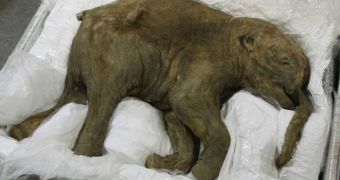The world's most complete preserved mammoth will be the centerpiece of a special exhibition called Ice Age Giants that will open next month at the Natural History Museum in London.
The fossil actually belongs to a baby woolly mammoth and was found in Siberia by a reindeer herder named Yuri Khudi in 2007. The man and his sons were reportedly searching for firewood in the frozen tundra when they stumbled upon the young animal, which is a little larger than a dog and is believed to have died when it was only one month old. They nicknamed it Lyuba, the Russian word for “love.”
Lyuba's permanent home is the Shemanovsky Museum in Russia, but will go on display to the British public on May 23 and will remain at the popular London museum for three months, until September 7, 2014. The fossil has previously been shown in Chicago and Hong Kong, but this is the first time it is part of an exhibition in Western Europe.
“The beautifully preserved body of the world's most complete woolly mammoth is on its way to the Natural History Museum from the Shemanovsky Museum in Russia as part of a new exhibition opening on May 23,” an article on the museum's website reads.
Experts who examined the fossil say it probably died 42,000 years ago, and described it as the most complete and well preserved woolly mammoth skeleton ever found, as reported by Daily Mail. They say that most of its body remained intact, and were able to determine its age because remnants of its mother's milk were still in its stomach.
Scientists also believe the body, which measures 130 cm (52 inches) long by 80 cm (31.5 inches) wide, is so well preserved because it sank into mud which later froze. It remained there for 40,000 years until it was found by the reindeer hunter along the banks of the Yuribei river.
Apparently, Lyuba is just one of a series of mammoths that have been found in the area in recent years.
“It's an honour to be showcasing the world's best preserved mammoth for the first time in western Europe. Lyuba is hugely important for helping us to understand the lives of ice age animals. This exhibition is a once-in-a-lifetime opportunity to meet this amazing creature from more than 40,000 years ago,” professor Adrian Lister, a mammoth researcher at the Natural History Museum, said.

 14 DAY TRIAL //
14 DAY TRIAL //